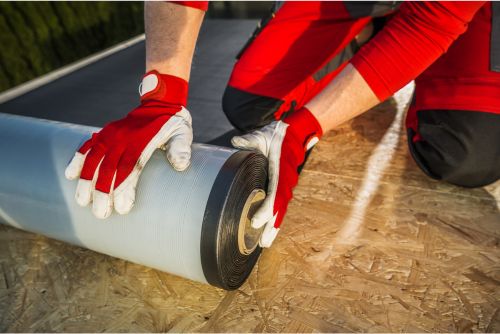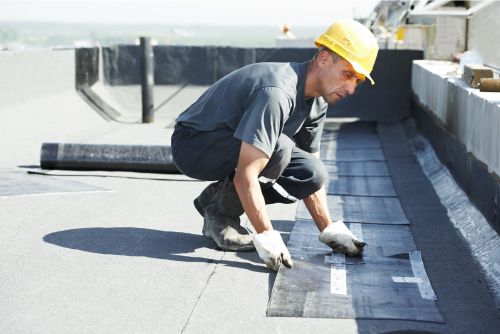
Commercial buildings require sturdy and reliable roofs to protect them from external elements and ensure the safety of occupants and assets. The construction of a commercial roof involves various materials, layers, and systems that work together to create a durable and long-lasting structure. In this blog, we will explore the process of how is a commercial roof constructed, understand its importance, and discuss the key differences between residential and commercial roofing.
Commercial roof construction involves the installation of a roofing system specifically designed for commercial buildings. It differs from residential roofing in terms of size, materials, and complexity. A commercial roof system is designed to withstand the challenges of a larger building and provide optimal protection against weather conditions. Understanding the construction process of a commercial roof is crucial for building owners, contractors, and anyone involved in the roofing industry.
Commercial roofing plays a vital role in protecting commercial buildings, making it an essential investment for building owners. A well-constructed commercial roof helps maintain energy efficiency, reducing energy costs for the building owner. It also protects the building from water damage, preventing structural issues and costly commercial roof repairs NJ. Regular maintenance of commercial roofing systems extends the roof’s life, ensuring long-term durability. Advanced commercial roofing materials offer heat resistance and UV protection, enhancing the energy efficiency and reflective properties of the building.
While residential and commercial roofs both serve the purpose of protecting buildings, there are several key differences between the two. First, commercial roofs are generally larger and more complex than residential roofs. They often have flat or low-slope designs, while residential roofs typically feature steep slopes. Commercial roofs also require stronger structural support due to their size and weight. The materials used in commercial roofing systems, such as modified bitumen, differ from those used in residential roofing. Lastly, commercial roofs require regular inspections and maintenance to ensure their integrity, as commercial buildings are subject to different regulations and codes than residential structures.

A commercial roof consists of several layers that work together to provide protection and insulation for the building. These layers include the structural deck, vapor barrier, roof insulation, roof adhesive and fasteners, cover board, and roof membrane. Each layer has a specific function, contributing to the overall durability and performance of the commercial roof system. Understanding the anatomy of a commercial roof is essential for contractors to understand how is a commercial roof constructed, building owners, and anyone involved in roof construction or maintenance.
The structural deck is the base layer of a commercial roof system, providing structural support and distributing weight evenly. It is typically made of materials such as steel, concrete, or wood, depending on the building’s location, size, and design. The structural deck must be properly installed and maintained to ensure the longevity and safety of the commercial roof. It serves as a foundation for the subsequent layers of the roof system, including insulation, vapor barrier, and roof membrane.
A vapor barrier is a crucial component of a commercial roof’s construction, preventing moisture from penetrating the roof system. It is typically made of materials such as asphalt, PVC, or rubber, depending on the type of roof system. The vapor barrier is placed strategically to prevent water damage and structural issues caused by moisture buildup. Proper installation and maintenance of the vapor barrier are essential to ensure the long-term durability of a commercial roof.
Roof insulation is an important element of commercial roof construction. It helps improve energy efficiency by reducing heat transfer between the building and the external environment. Properly installed insulation can result in significant energy cost savings for building owners. Different types of insulation materials, such as polyisocyanurate, mineral wool, and rigid foam, can be used in commercial roofing systems. Choosing the right insulation material and ensuring proper installation are crucial for optimal energy efficiency and cost savings.
Roof adhesive and fasteners are essential for securely attaching the various layers of a commercial roof system. Commercial roofing contractors NJ use adhesives and fasteners to ensure the stability and integrity of the roof assembly. The type of adhesive and fasteners used depend on the specific roofing materials and system being installed. Proper installation of roof adhesive and fasteners is crucial to prevent roof failure, water damage, and other issues that may compromise the performance of the commercial roof.
A cover board is a protective layer installed over the roof insulation, serving as a base for the roof membrane. It provides additional strength and durability to the roof surface, protecting it from foot traffic, extreme weather conditions, and other external elements. Cover boards can be made of materials such as polyisocyanurate, cementitious wood fiber, or gypsum, depending on the specific roof system and project requirements. A well-installed cover board enhances the performance and longevity of a commercial roof.
The roof membrane is the outermost layer of a commercial roof system, providing waterproofing and protection against external elements. It is typically made of materials such as modified bitumen, thermoplastic polyolefin (TPO), polyvinyl chloride (PVC), or ethylene propylene diene monomer (EPDM). The type of roof membrane used depends on factors such as the building’s location, climate, and project requirements. Roof membranes offer resistance to ultraviolet light, water damage, foot traffic, and extreme temperatures, ensuring the longevity and performance of the commercial roof system.

Commercial roofing systems utilize a wide range of materials, each with its unique properties and advantages. Metal roofing is known for its longevity, resistance to external elements, and reflective properties, making it a popular choice for commercial buildings. Thermoplastic polyolefin (TPO) roofing systems offer heat resistance, energy efficiency, and foot traffic resistance. Polyvinyl chloride (PVC) roofing materials provide resistance to water damage, extreme temperatures, and reflective properties. Built-up roofing (BUR) systems, comprising layers of bitumen membranes, offer durability, resistance to foot traffic, and extreme weather conditions. Ethylene propylene diene monomer (EPDM) roofing membranes provide foot traffic resistance, resistance to water damage, and ultraviolet light resistance.
Metal roofing is a popular choice for commercial buildings due to its longevity, durability, and low maintenance requirements. It offers excellent resistance to external elements, such as rain, snow, wind, and hail, ensuring the long-term protection of the building. Stainless steel metal roofing, in particular, is highly resistant to corrosion, rust, and fire, making it an ideal choice for commercial roofs. Metal roofing systems also have reflective properties, reducing energy costs by reflecting heat from the building and minimizing the need for air conditioning during hot weather.
Thermoplastic polyolefin (TPO) roofing systems are a popular choice for commercial flat roofs. TPO roofing membranes offer resistance to ultraviolet light, water damage, extreme temperatures, and foot traffic. They are highly reflective, reducing the roof’s life cycle costs by minimizing heat absorption. TPO roofs are energy-efficient, as they reflect sunlight instead of absorbing it, which helps reduce cooling costs. Additionally, TPO roofs are environmentally friendly and easy to install, making them a preferred choice for commercial roofing projects. Their single-ply system simplifies installation, reduces material waste, and minimizes the number of seams, enhancing the roof’s overall integrity.
Polyvinyl chloride (PVC) roofing membranes are known for their durability, resistance to water damage, extreme temperatures, and foot traffic. PVC roofs offer excellent heat resistance, reducing energy costs by minimizing heat transfer into the building. They also have reflective properties, helping to maintain a comfortable indoor temperature and reducing the workload of HVAC systems. PVC roofs are popular for their resistance to chemicals, fire, and UV radiation, ensuring the long-term performance of the roof. Additionally, PVC roofing membranes are flexible, allowing for easy installation, repair, and maintenance.
Built-up roofing (BUR) systems have been used for decades in commercial roofing, offering durability, resistance to water damage, extreme temperatures, and foot traffic. They consist of multiple layers of bitumen roofing felts alternated with layers of asphalt or coal tar. Here are some key points about BUR systems:
Ethylene Propylene Diene Monomer (EPDM) roofing membranes, made of synthetic rubber polymers, are commonly used in commercial roofing applications. Here are some key points about EPDM roofing:

Proper maintenance is crucial for maximizing the lifespan of a commercial roof and preventing costly commercial leak repair NJ. Regular roof inspections, combined with proactive maintenance, can identify and address potential issues early on. This helps extend the roof’s life and ensures its ongoing performance. Building owners should establish a routine maintenance plan, which includes regular inspections, cleaning, repair of problem areas, and proper drainage system maintenance. By investing in regular roof maintenance, building owners can avoid unexpected expenses, prolong the roof’s life, and protect their valuable assets.
Regular roof inspections are essential to identify problem areas and address them before they escalate into more significant issues. These inspections should be carried out by commercial roofing company NJ, who have the expertise to identify potential weaknesses in the roof system. Here are some key points about regular roof inspections:
The replacement of a commercial roof depends on various factors, including the type of roof system, foot traffic, external elements, and the overall roof’s life. Determining the need for commercial roof replacement NJ should be based on objective assessments by roofing professionals. Here are some key points to consider regarding roof replacement:
In conclusion, understanding the construction of a commercial roof is essential for anyone involved in the roofing industry or owning a commercial property. Commercial roofs play a vital role in protecting the building and its occupants from the elements. Key differences between residential and commercial roofing include the materials used and the complexity of the system. The anatomy of a commercial roof consists of various layers, including the structural deck, vapor barrier, insulation, and roof membrane. Different materials, such as metal roofing, TPO roofing, PVC roofing, BUR, and EPDM roofing, are commonly used in commercial roofing. Regular roof inspections and timely repairs are crucial for maintaining the longevity of a commercial roof. By understanding how is a commercial roof constructed and maintenance requirements, you can ensure the durability and performance of your commercial roof for years to come.